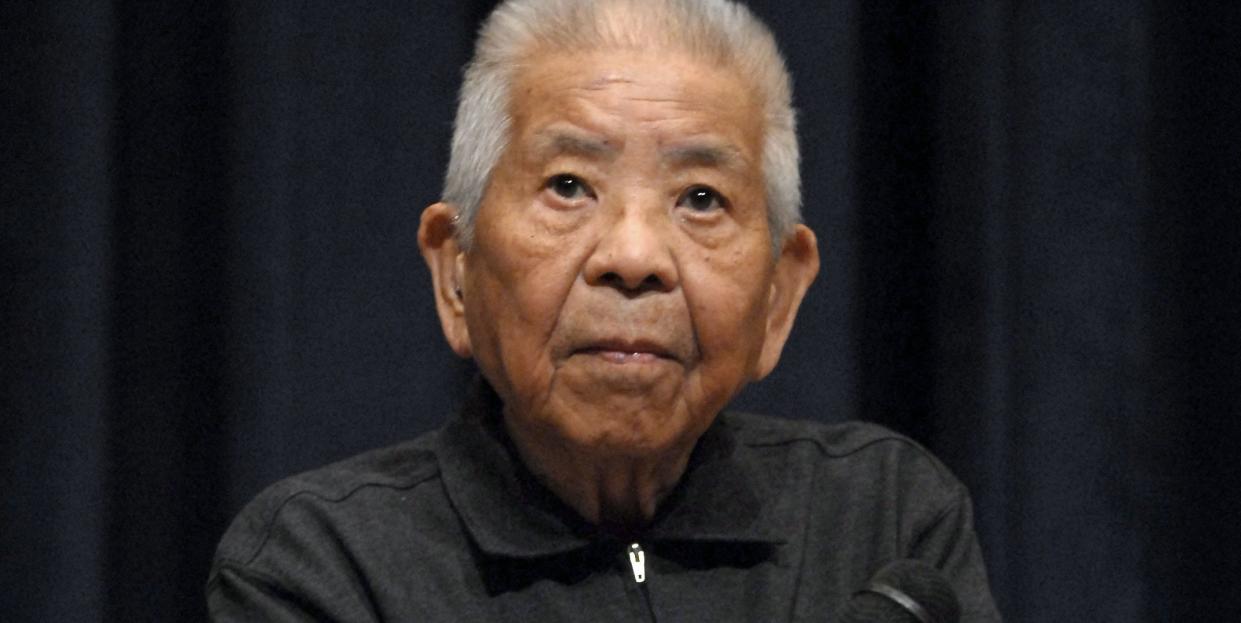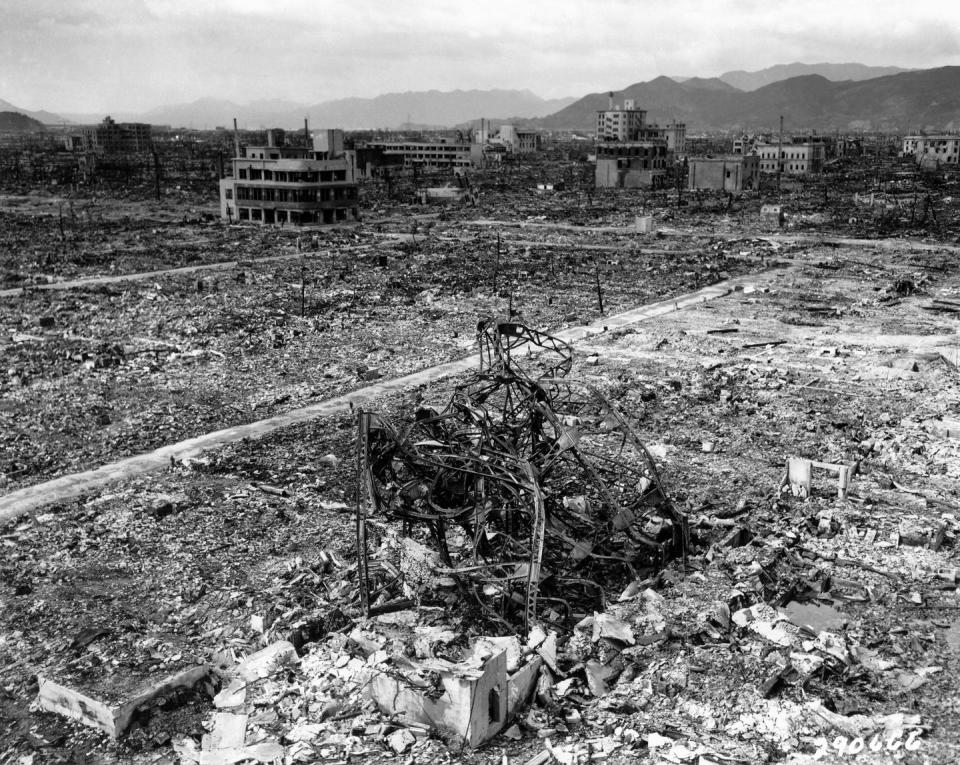The Man Who Miraculously Survived Both Atomic Bombings

- Oops!Something went wrong.Please try again later.
- Oops!Something went wrong.Please try again later.
"Hearst Magazines and Yahoo may earn commission or revenue on some items through these links."
About 650,000 people have been recognized by the Japanese government as hibakusha, referring to people who have been directly affected by the atomic bombings of Hiroshima and Nagasaki during World War II. But there has only ever been one person recognized as a nijyuu hibakusha, or “twice-bombed person.”
Tsutomu Yamaguchi was less than two miles from the blast zones of the Hiroshima and Nagasaki bombings and miraculously survived both without debilitating injuries. “My double radiation exposure is now an official government record,” Yamaguchi said. “It can tell the younger generation the horrifying history of the atomic bombings even after I die.”
The bombings on August 6 and August 9, 1945, are estimated to have killed as many as 226,000 people while completely destroying both cities. Recently, there’s been renewed interest in the origins of atomic weaponry due to the upcoming Christopher Nolan film Oppenheimer about physicist J. Robert Oppenheimer, the “father of the atomic bomb.”
Yamaguchi lived another 65 years after the attacks, before dying of stomach cancer at age 93. For several decades, he didn’t speak publicly about the devastation he witnessed, but in his final years, he felt it was his destiny to speak out against the horrors of nuclear weaponry.
“The reason that I hate the atomic bomb is because of what it does to the dignity of human beings,” Yamaguchi told Military History Magazine, according to several books and media outlets.
Surviving the Hiroshima Blast
Yamaguchi was born in Nagasaki, Japam, on March 16, 1916. In the 1930s, he began working as a draftsman for Mitsubishi Heavy Industries, designing oil tankers. He opposed his country’s role in World War II and became so despondent about the war that he considered killing his wife and infant son with sleeping pills if Japan lost.
Yamaguchi was in Hiroshima for a three-month business trip when the city was bombed on August 6, 1945. It was the last day of the trip, and he was preparing to leave the city when he saw the American B-29 bomber Enola Gay fly over Hiroshima and drop an item carried by two parachutes. Suddenly, he said the sky lit with a blaze, “the lightning of a huge magnesium flare.”
Drawing upon his naval air-raid training, Yamaguchi dove to the ground, rolled into the nearest irrigation ditch, flung his hands into his head, locked his fingers over his eyes, and jammed his thumbs into his ears, according to To Hell and Back: The Last Train from Hiroshima by Charles Pellegrino.
The ground roared and an ear-shattering noise ripped through the air, tossing Yamaguchi into the air as a fireball imploded overhead. He was dropped face-first into a muddy furrow. The protective measures he took likely saved his life; a woman who had been walking beside him shortly before the blast disappeared altogether, Pellegrino wrote.
“I think I fainted for a while,” Yamaguchi said. “When I opened my eyes, everything was dark, and I couldn’t see much. It was like the start of a film at the cinema before the picture has begun when the blank frames are just flashing up without any sound.”

Returning Home to Nagasaki
Surrounded by falling ash, Yamaguchi was temporarily blinded, and the explosion ruptured his eardrums and left him with serious radiation burns on his arms and face. He returned to Nagasaki the following day, encountering hellish scenes during his trip, including still-burning fires, shattered buildings, and melted corpses lining the streets.
Still wounded and heavily bandaged, Yamaguchi returned to work on August 9, the day Nagasaki was bombed. He was providing his supervisor a detailed account of the Hiroshima bombing when the landscape outside the office suddenly lit up in blinding light, and Yamaguchi fell to the floor as shockwaves destroyed the windows.
“Suddenly, the same white light filled the room,” he later recalled. “I thought the mushroom cloud had followed me from Hiroshima.”
Get the latest articles from Biography.com delivered straight to your inbox.
The city’s hilly landscape and a reinforced stairwell in the office protected the conference room where Yamaguchi and his colleagues were, according to Pellegrino. Having just heard his story, his coworkers took cover in a manner similar to how Yamaguchi did in Hiroshima, which helped protect them from the blast.
Fearing his family’s safety, Yamaguchi rushed home and was relieved to find his wife and son suffered only superficial injuries, though his wife was “soaked in black rain and was poisoned,” as their daughter later recalled. In the subsequent weeks, Yamaguchi suffered high fevers, severe hair loss, continuous vomiting, and other symptoms from radiation poisoning.
Life After the Bombings
Yamaguchi worked as a translator for Allied occupation forces after the war and taught school before eventually resuming his engineering career at Mitsubishi. He largely declined to discuss the bombings in public until the 2000s, when he became a vocal proponent of nuclear disarmament.
He wrote a memoir and a book of poems inspired by his experiences and participated in a documentary called Twice Survived (2006), which was screened at the United Nations. “I can’t understand why the world cannot understand the agony of the nuclear bombs,” he said. “How can they keep developing these weapons?”
Although Yamaguchi lived a long and relatively healthy life, he suffered from radiation-related ailments, including cataracts and acute leukemia, in his later years. His wife, who suffered radiation poisoning from the blasts, died at the age of 88 from kidney and liver cancer, and all three of their children reported suffering from health problems as well.
Yamaguchi died of stomach cancer on January 4, 2010, at the age of 93. A few months before his death, he said he was lucky to survive both atomic blasts, so “everything that follows is a blessing.” In his final years, he believed he was spared for a reason: “Having experienced atomic bombings twice and survived, it is my destiny to talk about it.”
You Might Also Like

